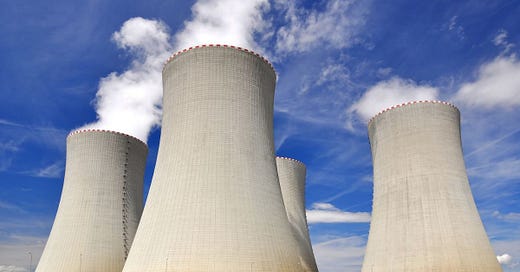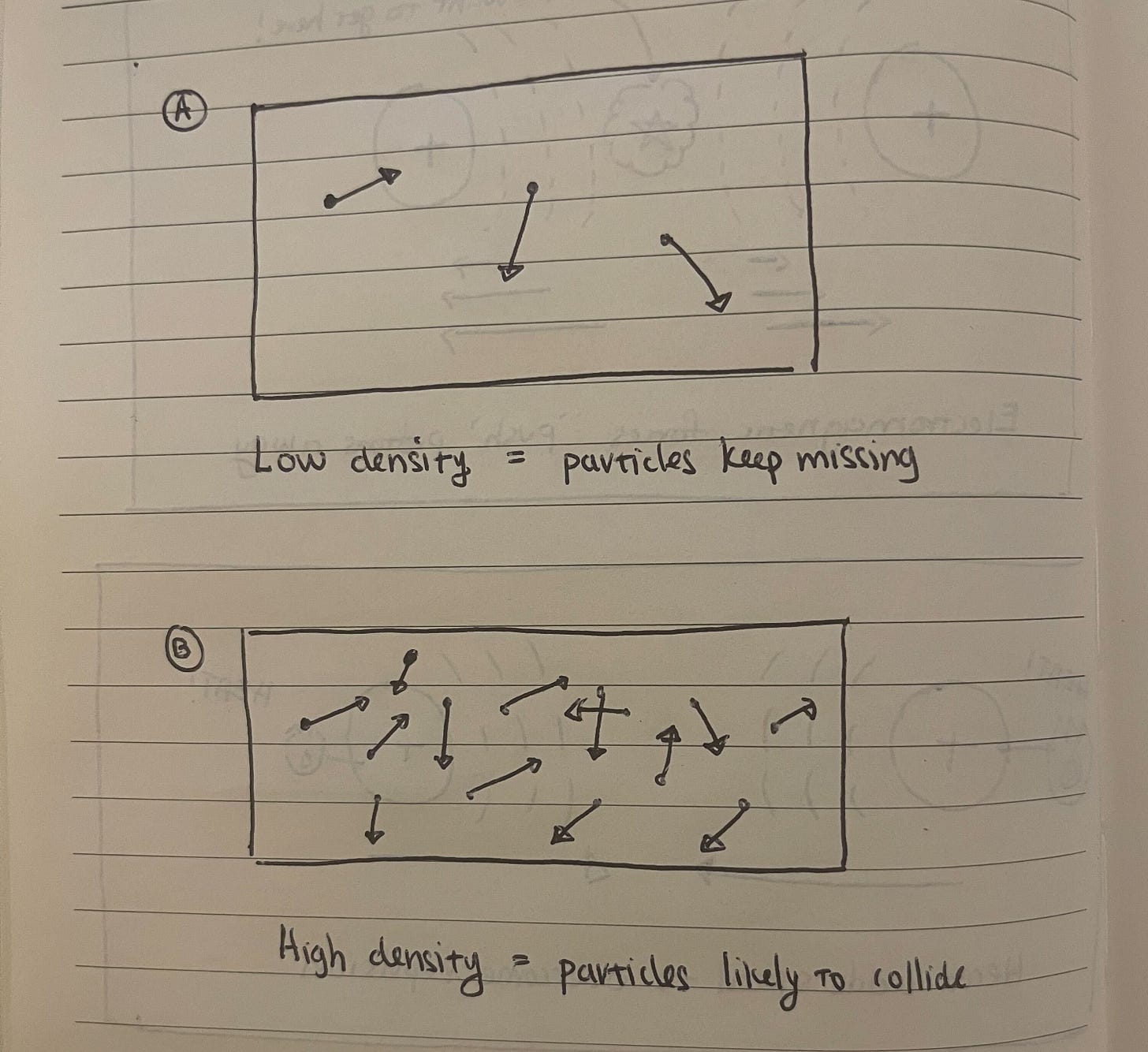Why do we need nuclear fusion?
Part 1 of a nuclear fusion series. Understanding why we might need nuclear fusion and how it works.
A major theme of this substack is figuring out how to build impactful careers by anticipating major technology shifts and taking action on this insight.
Last week, we explored how to predict the rise of a $100B vertically-integrated startup and clues to look for (exponential trends, off-path indicators, ground-zero conditions). This gave us a framework for how to evaluate which ideas will be important. But this is just theory and theory without practice is not useful.
Over the next few essays, we’re going to shift from theoretical to practical and explore an idea that just might change the world (if it works).
This idea is nuclear fusion.
Why this essay
I am starting with 0 knowledge of nuclear fusion, so this essay was born out of a desire to answer these questions. I’ll be releasing this in 3 parts.
Part 1 - nuclear fusion 101
What inspired nuclear fusion?
What is the current state of nuclear power?
What would solving nuclear fusion do for us?
What are the physics 101 of nuclear fusion?
Part 2 - nuclear fusion economy
What technologies will enable nuclear fusion?
What will the nuclear fusion economy look like as these technologies mature?
What new markets will appear?
Part 3 - nuclear deep-dives
Deep dive into Marathon Fusion
Why nuclear fusion?
When we look up at the night and view the stars, everything we see is shining because of distance nuclear fusion - Carl Sagan
Our sun is powered by nuclear fusion. Everyday, it fuses hydrogen nuclei together to form helium, releasing energy that is transmitted to earth. The sun and the stars in our galaxies are all real-life examples of nuclear fusion and they hint at the possibility of generating infinite, clean energy.
Therefore, the relevant question for nuclear fusion is this.
Is it possible to create fusion technology that simulates our stars so that we can also generate infinite, clean energy on earth?
Where are we today?
The world already generates substantial nuclear power today. But all nuclear power plants today are fission-based. Nuclear fission generates energy by splitting atoms. In contrast, nuclear fusion generates energy by fusing atoms. Although this essay is about fusion, it’s worth briefly understanding fission and its problems to motivate why we might care about fusion.
Nuclear Fission
Today, nuclear fission represents 10% of the world’s share of electricity. If you consider only the U.S., this share climbs to 20%, which is more than solar (6%) and wind (10%) combined.

What might be surprising is that nuclear fission might possibly be the safest and cleanest source of energy. In this case safety is measured by death-rate per unit of electricity generated and cleanliness by CO2-emissions.
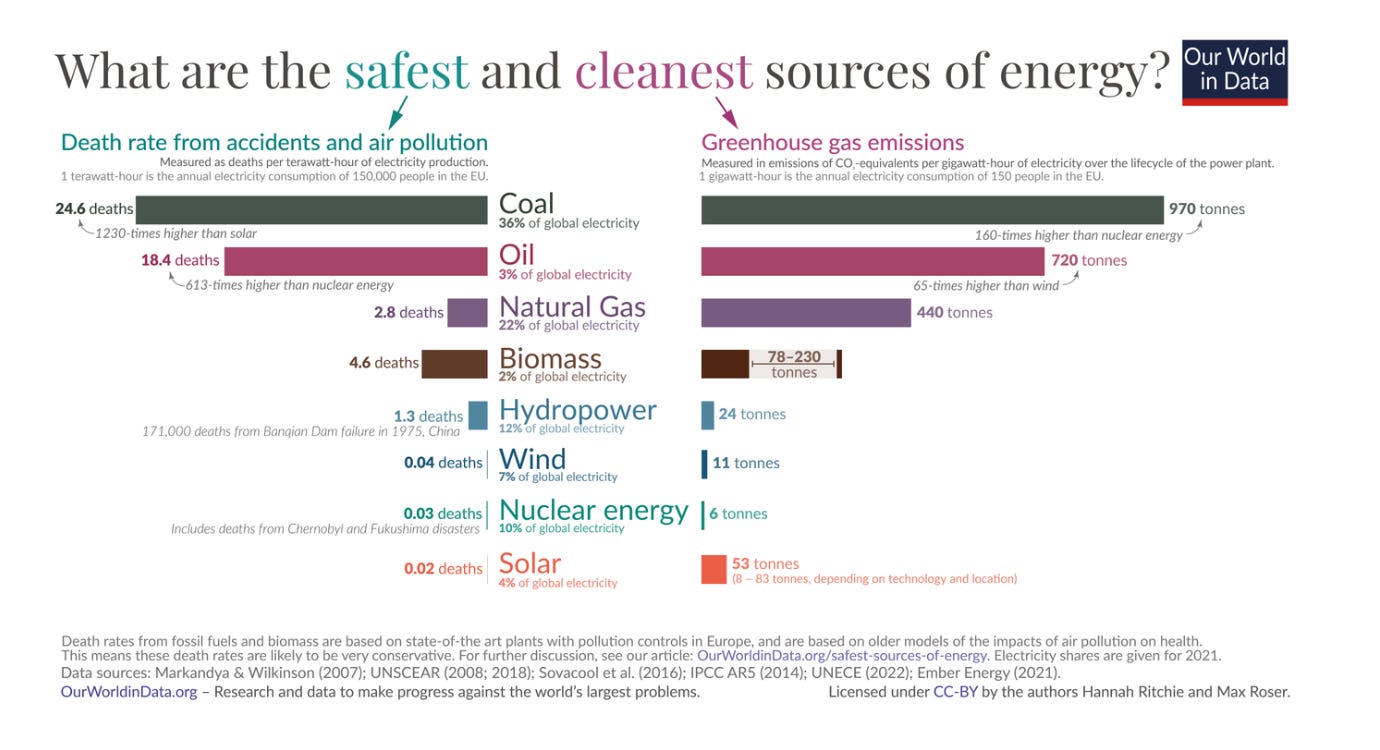
So why aren’t we building a lot more nuclear fission? There are two explanations.
The first is a societal argument. Julia DeWahl (founder of Antares, microreactors for nuclear fission) provides a list of historical reasons why people’s attitudes towards nuclear power are negative. These attitudes lead to fewer private and government funding for fission.
People associate nuclear with nuclear weapons
People associate nuclear with nuclear meltdowns (Chernobyl, Fukushima)
Mining uranium (fission fuel) is seen as dangerous
Fission creates nuclear waste that doesn’t decompose
The second is a cost argument. Constructing nuclear power plants is very expensive and this leads to nuclear energy being expensive compared to other energy sources. Specifically, the levelized cost of electricity generated by nuclear energy seems to be increasing over the past decade and is higher than alternative forms (solar, wind, fossil-fuels)1

Promise of nuclear fusion
Nuclear fusion represents an alternative to fission that eliminates many of fission’s weaknesses. There are 3 reasons why nuclear fusion might be attractive.
Reason 1 : Abundant, limitless energy
The fuel that nuclear fusion will use are isotopes of hydrogen (Deuterium, Tritium). Deuterium is found in natural water so it is basically limitless. Although Tritium doesn’t exist naturally, we can build it from lithium which is readily available. Assuming we can get nuclear fusion to work, we’d have enough fuel on earth to power our current electricity needs for 100 million years.
Reason 2 : High energy density
One way to measure the “goodness” of an energy source is energy density. High energy density means we prefer fuel sources that generate a lot of energy, but don’t weigh a lot. Nuclear fusion works by modifying the nuclei of atoms (i.e. nuclear energy) as opposed to burning fossil-fuels which works by modifying the electrons' orbits (i.e. chemical energy). This is relevant because the potential energy stored in nuclear bonds is significantly higher than that of chemical bonds. It turns out the energy density of nuclear fusion is 4 times better than nuclear fission and 1 million times better than fossil-fuels.
Reason 3: Environmental impact & safety
Unlike fossil-fuels or nuclear-fission, the waste product of nuclear fusion is helium (which is environmentally friendly and easy to deal with). Because nuclear fusion isn’t based on chain-reactions (unlike fission), it is often considered safer because there’s no risk of nuclear meltdown.
What will it take for fusion to be adopted?
Because nuclear fusion represents a cleaner, safer and more energy-abundant form of nuclear fission, the barrier to adopting fusion comes down to if it can beat the levelized cost of electricity for other fuel sources. In short, 2 things need to happen for nuclear fusion to be adopted.
Show that building a nuclear reactor can achieve net-energy gain
Show that generating nuclear energy is cheap, measured by levelized cost of electricity
Physics 101 of fusion
The idea behind nuclear fusion is to collide two atomic nuclei with each other so they fuse and form a heavier atomic nucleus. When this fusing happens, a massive amount of energy is released and this energy can be captured and converted to electricity. Fusion is possible because of strong nuclear force, a phenomenon in physics wherein two nuclei will attract each other and fuse once they get sufficiently close (i.e. think of this as 2 attracting magnets but at the atomic level). The sun is an example of real-life fusion.

The 3 ingredients of nuclear fusion
Solving nuclear fusion means we can design a reactor that can artificially create the conditions for fusion and generate energy. At a basic level, a reactor has to do 3 jobs
Temperature : heat the fuel source
Density : pack a lot of fuel source into a small space
Confinement Time : maintain temperature and density for a long period of time
Let’s understand why these 3 ingredients are required, 1 ingredient at a time.
Why temperature (T)
To trigger nuclear fusion, we need to bring two nuclei closer and closer to trigger fusion. This is because once two nuclei get sufficiently close, they will be attracted by strong nuclear force. But there’s a problem! It’s hard to bring two nuclei close together. Each nuclei has protons with positive charge and these protons repel each other, which means that as you bring two nuclei together, their respective protons repel each other because of electromagnetic force.
How do we get nuclei close despite this competing, repulsive force? Use heat! By heating the fuel source, the reactor adds kinetic energy to the nuclei. With sufficient temperature, the nuclei have enough kinetic energy to overcome the repulsive force of protons. This is known as overcoming the coulomb barrier.
The temperature needed for nuclear fusion is incredibly high (10 KeV, 100x hotter than the sun) and when we reach this temperature the fuel source turns into plasma, which is the 4th state of matter. Nuclear reactors heat fuel sources to turn them into plasma, then confine and hold this plasma at required temperatures to trigger fusion.
Why density (D)
After a nuclear reactor converts the fuel source into plasma, the second job is to achieve density. Density refers to the number of fuel particles in a given area. Low density means a small number of fuel particles in a space. High density means a large number of fuel particles in a space. As density increases the probability that two fuel particles will collide with each other and fuse. Another way to think about is if there’s low density, the fuel particles will just bounce around in air and miss each other).
Why confinement time (N)
Confinement time refers to the amount of time that a reactor can sustain the required levels of heat and density. Once we achieve the right conditions for fusion, we need to give time for collisions to happen (i.e. more time = more collisions).
We want Q > 1, the holy grail for fusion
Fundamentally, good nuclear fusion is about getting more energy out than we put in. If we get 1x energy, but it takes us 100x the energy to heat and pack our fuel source to achieve fusion, then nuclear fusion is not economically viable. We call this fusion energy gain (Q). Note that Q > 1 means we get more energy out than we put in.
The problem of fusion is to achieve high Q by varying these 3 ingredients.
Temperature (T) is needed to overcome the coulomb barrier and trigger nuclear strong force
Density (D) is needed to increase the probability that 2 fuel particles will collide and fuse
Confinement time (N) is needed to increase the probability that 2 fuel particles will collide and fuse
Mathematically, we’re saying that Q is proportional those 3 ingredients and we are looking for some magical combination that gives us Q > 1. If you have one takeaway, know that this is the problem that fusion startups are trying to solve.
So the open question is
Can we build a nuclear reactor that achieves the required temperature, density and confinement time needed to achieve Q > 1?
Lawson Criteria and ignition
A useful way to analyze this question is looking at the Lawson criteria (also known as the triple product). The lawson criteria is the product of temperature, density and confinement time and it’s used as a performance metric for nuclear reactors. The intuition is that high lawson criteria correlates with more nuclear reactions. More nuclear reactions means more energy output.
The graph below shows the temperature (x-axis) and Lawson criteria (y-axis) achieved by various nuclear fusion experiments. The colored orange establishes a baseline (Q=0.1, Q=1) and highlights all the nuclear fusion experiments that achieved this Q value. As expected, higher lawson criteria leads to higher Q.

Attentive readers will notice a term called ignition on the graph. If we can achieve a high enough Lawson criteria (temperature, density and confinement time) then the nuclear fusion reactions from the plasma will generate enough heat where you no longer need external sources of heating. This is important because it means we only need to heat the reactor once until maintaining heat becomes free. Ignition represents the point at which this happens.
Fuel sources (deuterium H2 & tritium H3)
So far, we’ve covered the 3 main ingredients for fusion (temperature, density and confinement time), but we’ve only talked about fusion fuel sources in the abstract. When we say 2 nuclei collide and fuse, what specifically do we mean by particles? Is it hydrogen, helium, nitrogen, etc? Currently, the dominant fuels used for nuclear fusion are deuterium (H2) and tritium (H3) - both are isotopes of hydrogen
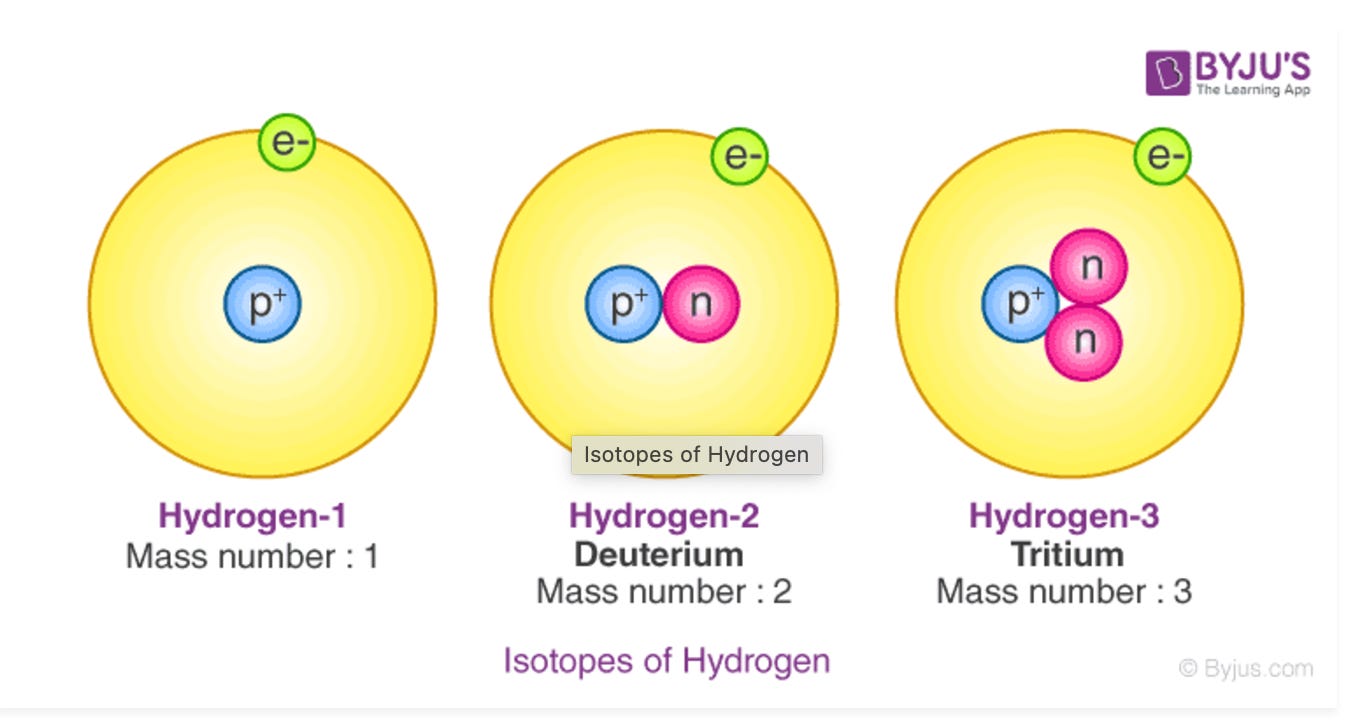
Why Tritium and Deuterium? This has to do with how easy certain fuels are for triggering fusion.
The graph below shows how combinations of fuel and the likelihood of fusion. Notice that heavier elements are harder to fuse (Li6, N14). this is because they have a lot more protons so the force needed to overcome their coulomb barrier is high. But proton repulsion is not the only consideration (otherwise we’d just pick H1 w/ H1). The other combos been experimentally verified to show the fuel combos that have the highest rates of fusion.
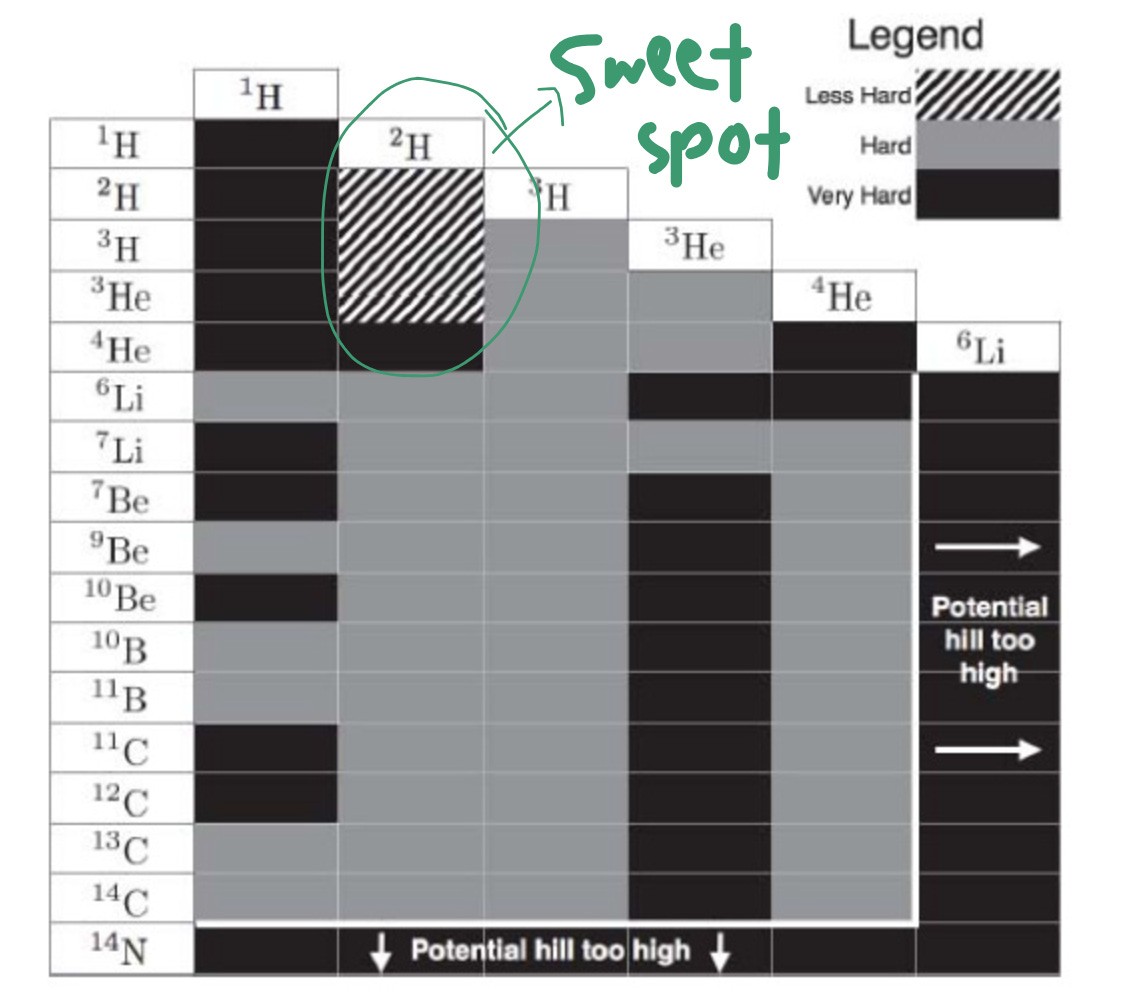
What’s next
The goal of today’s essay was to provide a basic 101 understanding on nuclear fusion (why we care about it and how it works). In part 2 and 3, we’ll dig into the various technologies the nuclear fusion community is developing to solve Q > 1. Specifically, we’ll be exploring the question
What does the fusion economy look like if fusion starts to work?
What opportunities will exist for founders and investors as the space takes off?
Also, I’m going back to my roots so I want to say no GPT or Claude was used when creating this post.
A levelized-cost of electricity measures the cost of generating from a specific power source over its lifetime (including upfront construction costs, maintenance cost and fuel costs).

